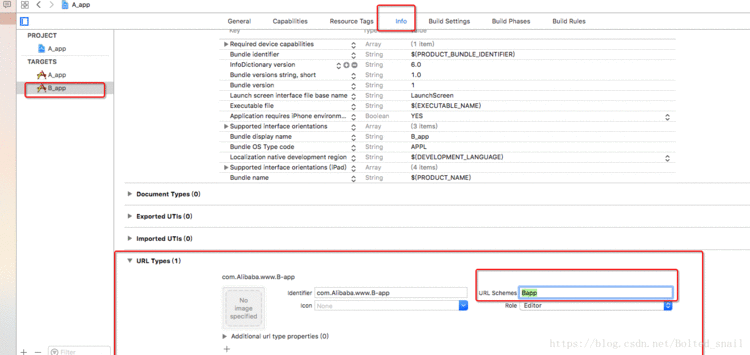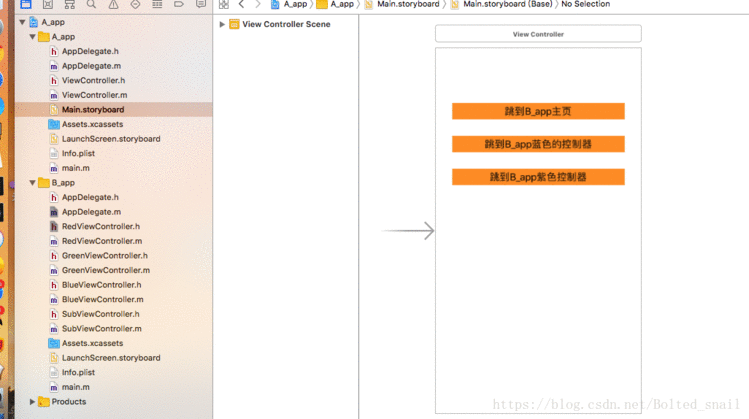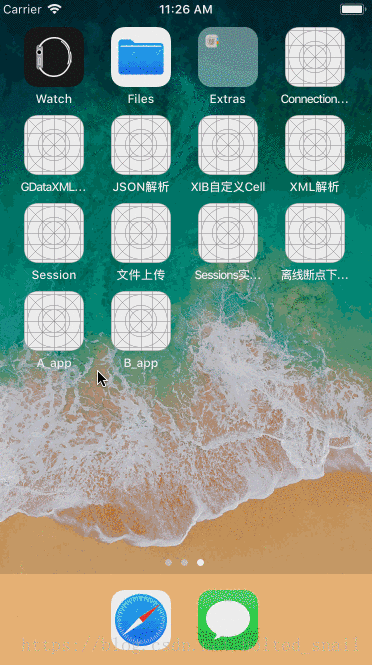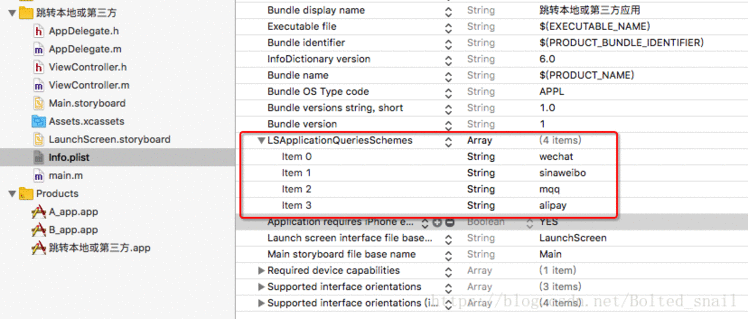
canOpenURL:方法,该方法所涉及到的 URL Schemes 必须在”Info.plist”中将它们列为白名单,否则不能使用。key叫做LSApplicationQueriesSchemes ,键值内容是对应应用程序的URL Schemes。具体设置如下图:
UIApplication的canOpenURL方法,协议头后面可以拼接参数传递过去,如下所示:NSURL * appurl = [NSURL URLWithString:@"Bapp://"];
//判断是否安装了对应的应用,安装了就打开
if ([[UIApplication sharedApplication] canOpenURL:appurl]) {
[[UIApplication sharedApplication]openURL:appurl];
}else{
UIAlertView * alertV = [[UIAlertView alloc]initWithTitle:@"提示" message:@"请安装相应的应用" delegate:nil cancelButtonTitle:@"关闭" otherButtonTitles:nil, nil];
[alertV show];
}
5.当A_app调用了canOpenURL方法,B_app会响应- (BOOL)application:(UIApplication *)app openURL:(NSURL *)url options:(NSDictionary代理方法,在该代理方法中可以获取传过来的URL,通过拦截url传过来的参数可以处理跳到对应的模块。
Main.storyboard中添加三个按钮
#import "ViewController.h"
@interface ViewController ()
@end
@implementation ViewController
- (IBAction)jumpToHome:(id)sender {
//注意设置URL Schemes 事里面不要有“—”,否则可能会跳不过去
NSURL * appurl = [NSURL URLWithString:@"Bapp://"];
//判断是否安装了对应的应用,安装了就打开
if ([[UIApplication sharedApplication] canOpenURL:appurl]) {
[[UIApplication sharedApplication]openURL:appurl];
}else{
UIAlertView * alertV = [[UIAlertView alloc]initWithTitle:@"提示" message:@"请安装相应的应用" delegate:nil cancelButtonTitle:@"关闭" otherButtonTitles:nil, nil];
[alertV show];
}
}
- (IBAction)jumpToBlue:(id)sender {
NSURL * appurl = [NSURL URLWithString:@"Bapp://BlueViewController"];
if ([[UIApplication sharedApplication] canOpenURL:appurl]) {
//iOS10以后过期
[[UIApplication sharedApplication]openURL:appurl];
}else{
UIAlertView * alertV = [[UIAlertView alloc]initWithTitle:@"提示" message:@"请安装相应的应用" delegate:nil cancelButtonTitle:@"关闭" otherButtonTitles:nil, nil];
[alertV show];
}
}
- (IBAction)jumpToPurple:(id)sender {
NSURL * appurl = [NSURL URLWithString:@"Bapp://SubViewController"];
if ([[UIApplication sharedApplication]canOpenURL:appurl]) {
//iOS10以后有效
[[UIApplication sharedApplication]openURL:appurl options:nil completionHandler:nil];
}
}
@end
应用程序B_app中文件结构和AppDelegate主要实现方法:

主要实现的代理方法:
#import "AppDelegate.h"
@interface AppDelegate ()
@end
@implementation AppDelegate
- (BOOL)application:(UIApplication *)application didFinishLaunchingWithOptions:(NSDictionary *)launchOptions {
self.window = [[UIWindow alloc]initWithFrame:[UIScreen mainScreen].bounds];
self.window.backgroundColor = [UIColor whiteColor];
UITabBarController * tabbarVC = [[UITabBarController alloc]init];
NSArray * rootVCNameArray = [NSArray arrayWithObjects:@"RedViewController",@"GreenViewController",@"BlueViewController", nil];
for (NSString * vcName in rootVCNameArray) {
UIViewController * vc = [[NSClassFromString(vcName) alloc]init];
UINavigationController * navVC = [[UINavigationController alloc]initWithRootViewController:vc];
navVC.navigationBar.tintColor = [UIColor brownColor];
navVC.title = vcName;
[tabbarVC addChildViewController:navVC];
}
self.window.rootViewController = tabbarVC;
[self.window makeKeyAndVisible];
return YES;
}
//当其他应用跳转到当前应用就会调用该代理方法,iOS9及以后有效
- (BOOL)application:(UIApplication *)app openURL:(NSURL *)url options:(NSDictionary<UIApplicationOpenURLOptionsKey,id> *)options{
//获取跟控制器
UITabBarController * tabbarVC = (UITabBarController *)self.window.rootViewController;
NSLog(@"scheme : %@",url.scheme);
NSLog(@"absoluteString : %@",url.absoluteString);
if ([url.absoluteString containsString:@"BlueViewController"]) {
tabbarVC.selectedIndex = 2;
}else if ([url.absoluteString containsString:@"SubViewController"]){
tabbarVC.selectedIndex = 0;
UIViewController * vc = [[NSClassFromString(@"SubViewController") alloc]init];
[tabbarVC.childViewControllers.firstObject pushViewController:vc animated:YES];
}
return YES;
}
//-(BOOL)application:(UIApplication *)application openURL:(NSURL *)url sourceApplication:(NSString *)sourceApplication annotation:(id)annotation{
// return YES;
//}
//-(BOOL)application:(UIApplication *)application handleOpenURL:(NSURL *)url{
//
// return YES;
//}
@end
最终效果图:

如果想跳回A_app,可以添加A的URL Schemes,在B_app中添加白名单,调用openURL方法即可。
@{ "APP":@"打电话",@"Schemes":@"tel"},
@{ @"APP":@"发短信",@"Schemes":@"sms"},
@{ @"APP":@"打开日历",@"Schemes":@"calshow"},
@{ @"APP":@"提醒",@"Schemes":@"x-apple-reminder"},
@{ @"APP":@"邮件",@"Schemes":@"message"},
@{ @"APP":@"iTunes Store",@"Schemes":@"itms"},
@{ @"APP":@"App Store",@"Schemes":@"itms-apps"},
@{ @"APP":@"iBooks",@"Schemes":@"ibooks"},
@{ @"APP":@"Facetime",@"Schemes":@"facetime"}
<key>LSApplicationQueriesSchemes</key>
<array>
<!-- 微信 URL Scheme 白名单-->
<string>wechat</string>
<string>weixin</string>
<!-- 新浪微博 URL Scheme 白名单-->
<string>sinaweibohd</string>
<string>sinaweibo</string>
<string>sinaweibosso</string>
<string>weibosdk</string>
<string>weibosdk2.5</string>
<!-- QQ、Qzone URL Scheme 白名单-->
<string>mqqapi</string>
<string>mqq</string>
<string>mqqOpensdkSSoLogin</string>
<string>mqqconnect</string>
<string>mqqopensdkdataline</string>
<string>mqqopensdkgrouptribeshare</string>
<string>mqqopensdkfriend</string>
<string>mqqopensdkapi</string>
<string>mqqopensdkapiV2</string>
<string>mqqopensdkapiV3</string>
<string>mqzoneopensdk</string>
<string>wtloginmqq</string>
<string>wtloginmqq2</string>
<string>mqqwpa</string>
<string>mqzone</string>
<string>mqzonev2</string>
<string>mqzoneshare</string>
<string>wtloginqzone</string>
<string>mqzonewx</string>
<string>mqzoneopensdkapiV2</string>
<string>mqzoneopensdkapi19</string>
<string>mqzoneopensdkapi</string>
<string>mqzoneopensdk</string>
<!-- 支付宝 URL Scheme 白名单-->
<string>alipay</string>
<string>alipayshare</string>
</array>

#import "ViewController.h"
@interface ViewController ()<UITableViewDataSource,UITableViewDelegate>
@property(nonatomic ,copy) NSArray * dataSource;
@end
@implementation ViewController
-(NSArray *)dataSource{
if (!_dataSource) {
_dataSource = @[
@{ @"APP":@"打电话",@"Schemes":@"tel"},
@{ @"APP":@"发短信",@"Schemes":@"sms"},
@{ @"APP":@"打开日历",@"Schemes":@"calshow"},
@{ @"APP":@"提醒",@"Schemes":@"x-apple-reminder"},
@{ @"APP":@"邮件",@"Schemes":@"message"},
@{ @"APP":@"iTunes Store",@"Schemes":@"itms"},
@{ @"APP":@"App Store",@"Schemes":@"itms-apps"},
@{ @"APP":@"iBooks",@"Schemes":@"ibooks"},
@{ @"APP":@"Facetime",@"Schemes":@"facetime"},
@{ @"APP":@"微信",@"Schemes":@"wechat"},
@{ @"APP":@"微博",@"Schemes":@"sinaweibo"},
@{ @"APP":@"QQ",@"Schemes":@"mqq"},
@{ @"APP":@"支付宝",@"Schemes":@"alipay"},
];
}
return _dataSource;
}
-(NSInteger)tableView:(UITableView *)tableView numberOfRowsInSection:(NSInteger)section{
return self.dataSource.count;
}
- (UITableViewCell *)tableView:(UITableView *)tableView cellForRowAtIndexPath:(NSIndexPath *)indexPath{
UITableViewCell * cell = [tableView dequeueReusableCellWithIdentifier:@"JHCell"];
NSDictionary * dic = self.dataSource[indexPath.row];
cell.textLabel.text = [dic valueForKey:@"APP"];
cell.detailTextLabel.text = [dic valueForKey:@"Schemes"];
return cell;
}
-(void)tableView:(UITableView *)tableView didSelectRowAtIndexPath:(NSIndexPath *)indexPath{
NSDictionary * dic = self.dataSource[indexPath.row];
NSString * schemes = [dic valueForKey:@"Schemes"];
NSURL * url = [NSURL URLWithString:[NSString stringWithFormat:@"%@://",schemes]];
if ([[UIApplication sharedApplication] canOpenURL:url]) {
[[UIApplication sharedApplication]openURL:url options:nil completionHandler:nil];
}
}
@end
效果图如下:


 京公网安备 11010802041100号 | 京ICP备19059560号-4 | PHP1.CN 第一PHP社区 版权所有
京公网安备 11010802041100号 | 京ICP备19059560号-4 | PHP1.CN 第一PHP社区 版权所有